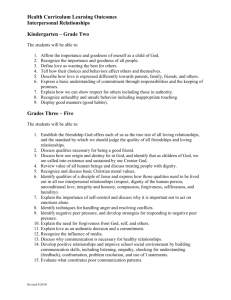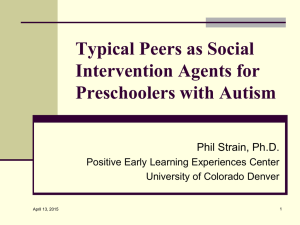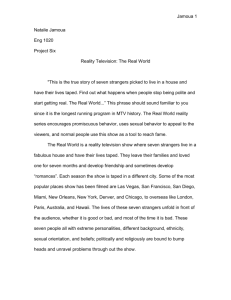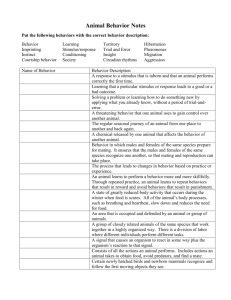Prospectus for senior research project
advertisement
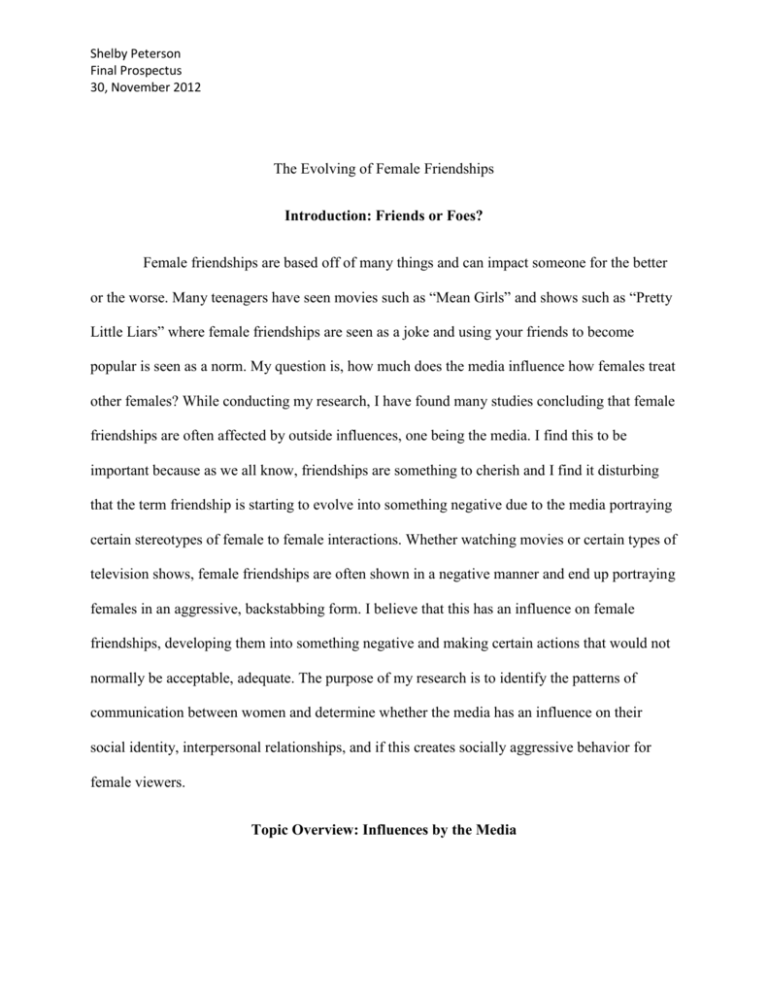
Shelby Peterson Final Prospectus 30, November 2012 The Evolving of Female Friendships Introduction: Friends or Foes? Female friendships are based off of many things and can impact someone for the better or the worse. Many teenagers have seen movies such as “Mean Girls” and shows such as “Pretty Little Liars” where female friendships are seen as a joke and using your friends to become popular is seen as a norm. My question is, how much does the media influence how females treat other females? While conducting my research, I have found many studies concluding that female friendships are often affected by outside influences, one being the media. I find this to be important because as we all know, friendships are something to cherish and I find it disturbing that the term friendship is starting to evolve into something negative due to the media portraying certain stereotypes of female to female interactions. Whether watching movies or certain types of television shows, female friendships are often shown in a negative manner and end up portraying females in an aggressive, backstabbing form. I believe that this has an influence on female friendships, developing them into something negative and making certain actions that would not normally be acceptable, adequate. The purpose of my research is to identify the patterns of communication between women and determine whether the media has an influence on their social identity, interpersonal relationships, and if this creates socially aggressive behavior for female viewers. Topic Overview: Influences by the Media When watching a movie or a television show, viewers tend to become absorbed in the plot and the characters, which can often lead to a negative result such as a change in attitude and personality. If the viewer tends to find some sort of relation to the character and the drama they are involved in, this creates a social identity. When someone finds some sort of connection within a media figure it helps them develop their self-identity and form social attitudes that will satisfy their needs for belonging. An important aspect to point out when talking about the influence the media may have on young females is the molding of socially aggressive behavior. Certain studies I have researched show that as young adults, it is easy to adopt certain behaviors. With this, it leads to young viewers picking up on aggressive behaviors and after viewing it routinely, it becomes present in their everyday lives. Goldberg (2011) found that socially aggressive behavior in young females is known to affect them tremendously in ways in which it creates depression, substance abuse, eating disorders and so on. An article written by Dr. Lauren Hughes (2012) published by ABC News found that out of the 50 most popular television shows for children, 92 percent of the programs contained some sort of social aggression, both verbal and non-verbal forms. She then described socially aggressive behaviors as acts that “damage social status, self-esteem, or both” (Hughes, 2012). A similar article that was published through Scientific American written by Jessee Bering (2009) defined socially aggressive behaviors in females as eye-rolling, gossiping, ostracizing, and bitchery comments. Another important influence the media can have on young females is seen within their interpersonal relationships. The relationship one has with another person is based on many different things and is formed by certain connections being present. Through my research, I have concluded that the media has a negative influence on interpersonal relationships due to certain television shows and movies portraying female friendships stereotypically. In conclusion, the media is influencing and changing what people believe a true friendship is and what it should entail. This communication phenomenon is important to study because “identifying with media figures allows us to experience social reality from other perspectives and, thus, shapes the development of self-identity and social attitudes (Cohen, 2001). The repeated exposure to stereotypical female clicks, like female to female interactions in movies such as Mean Girls and White Chicks, will allow viewers to identify with the characters and their actions, which will eventually become a mainstream behavior. The purpose of this study is to discover the relationship between the media and its female viewers and determine the effects the media may have on their interpersonal relationships and social identities, and their behaviors. I will ground my research by first studying the effects the media has on young female viewers. Second, analyzing their identification with media figures. Finally, I will research if this has any effect on one’s own relationship with other females. Let’s Talk Theory According to Lattimore, Baskin, Heiman, and Toth, (2009) social learning theory are ways in which an individual processes information. This theory allows us to take note of behaviors that interest us and determine whether that behavior would be rewarding to us or not. They go on to describe that when we note something from the media that we like, we think about it and if the rewards of using it seem positive, we will store it and use it when it is beneficial to us. In relation to my research topic, one may see an act of betrayal over and over again while watching their favorite shows so in terms of Social Learning Theory, by processing the betrayal acts, we may start to use those acts in our own lives. For more theoretical background, I chose to focus on is the organismic view of emotions. This theory states that we experience psychological change when we practice an emotion that stimulates a change in us. Wood (2009) states that when an event occurs, we first experience a psychological change and second, an emotional change. Sooner or later we will start executing the same emotions with the same occurrences of events. Emotions are our own experiences and interpretations of specific incidences and are all shaped by physiology, perceptions, language, and social experiences. With this theory, my research will focus on the reactions females have to specific situations, defining our emotions. Watching females in the media constantly backstab and spread rumors will set off a psychological change in female’s bodies allowing them to feel a certain emotion. This emotion can then be found within female friendships whether negative or positive, creating a connection with the emotions the media stimulates and the emotions that are stimulated within a friendship, possibly having some sort of influence on each other. Literature Review: Always be Yourself Identification: Who Am I? According to Cohen (2001) identification is found when viewers experience a sense of reality when watching a certain action take place within a plot. Viewers tend to find some sort of common ground between their reality and the characters’ reality leading them to identify themselves through the characters. Cohen (2001) performed a textual analysis and pulled findings from many different scholars who used different approaches to define identification. Cohen developed his definition of identification as fantasizing about being a specific character. He measured this through a scale on how much one liked the character, how much they wanted to be the character, and how much they can relate to the character through means of a survey. Some scholars measured through a wide range of survey questions to rate their similarity, friendship, and role modeling. They then measured their responses in terms of the feelings their audience received and the intensity of their feelings while analyzing their character. The results Cohen (2001) reported focused on defining identification and suggested that roles of socialization and persuasion are ways that people create their own identities that are influenced by watching the media; Researchers found an influence of media characters on their viewers. They related all this to social influence and by means of the research, found that watching media characters brought out a sense of identity in some, helping them create their identities. Studies done by Cohen (2001) brought up a research gap that helped me further my research. I began to research the impact a characters role can have on a viewer if the viewer experiences a reference of reality when watching television. If certain negative events are happening in movies or on television that the viewer can relate to, does this impact their social reality in a negative way? Will they form low self-esteem and have a behavior that is socially aggressive if their character is portraying such traits? A quantitative study that was done by Hawkins, Granley, Richards, and Stein (2004) helped me fill this gap. 145 undergraduate women were tested to see how the media affects their lifestyles, anywhere from eating disorders to mood swings. The women were given pictures of models (thin, medium, and plus) and then questioned about their responses and their feelings towards the pictures. The results of the survey showed that after looking at the “thin model” images, the women were more dissatisfied with their body image and had decreased self-esteem right away. They began thinking about their body image and comparing it to the models. They also mentioned they felt a sense of jealousy. After looking at “medium models” they felt a little better about themselves. After looking at images of ‘plus models” they noted how they relaxed and felt more comfortable. The women had immediate effects to these pictures leading to my argument that women are affected by the media. It is allowing us to believe that being beautiful is everything and the stereotype of female friendships that the media is supporting is normal and that it is accepted for women to lie and cheat in order to create a higher status for oneself. According to Identity Construction and Social Positioning (finding one’s self by relating to the behavior of others), Chittenden (2011) believes that certain situations that are shown on television shows such as The Hills can teach young females how to not only stand behind their values, but how to present them, and if necessary, how to defend them and their position to others. The textual analysis that was done by Tara Chittenden on the MTV reality show The Hills points out many great examples of female characters standing up for what they believe in and often having many confrontational situations that turned bad. The study that was done for this article was by means of observing season four of The Hills and analyzing the casts’ conversations to understand their identities. The article argues the importance of peer conversations and how it shapes the identities of young females. The research found that TV programs teach their viewers “modes of communication” and as young females being the audience, it is important that they are being shown the correct way to communicate with others and how to form their identity as young adults. The results from Chittenden textual analysis also summarized that viewers find closeness to media figures that seem to be like them or is someone who shares the same interest. For the cast of “The Hills” many teenage girls found themselves relating to the drama on the show. Chittenden believes that shows like The Hills can have a positive effect on female to female interactions by showing someone how to stand behind their beliefs and to not shy away from their values as a young female. Furthermore, there is a negative side to having popular television shows in that the drama that is on the shows can be seen as a mainstream action through the viewer’s eyes. Overall, I believe female viewers identify with characters who remind them of themselves. This leads to them forming a connection and holding on to it, finding their identity within the character. Interpersonal relationships: Who are We? As stated, I want to find the correlation between relationships with media figures and ones interpersonal relationships. Studies done by multiple scholars conclude that interpersonal relationships are changed and influenced by media figures that viewers find a relation with. Cohen (2010) conducted a qualitative study to “discover the extent to which individuals’ relationships with media figures resemble their interpersonal relationships.” 125 undergraduate students were given a questionnaire that had them select a close friend and a media figure of the same sex and rate their closeness to each individual they choose on a scale of 1-5. Further questions were asked that would help them identify their relationship and for them to analyze their differences on moral, trust, and social issues. This quantitative study pinpointed the effects of a relationship with an individual and their selected media figures and how that relationship influences their interpersonal relationships. Results found that viewers compare their media figure with the friends in real life. They tend to change their behaviors and react in ways that their media character often portrays changing the status of their relationships with their friend in either a positive or negative way depending on the actions of their selected media figure. Studies done by Chittenden (2011) highlight how “teens integrate media cultures into their everyday lives and negotiate meanings around these forms of communication.” In other words, teens pick up on things that the media portrays and they begin to change and adapt to the forms of communication that are being repeatedly represented. This connects to how the media is influencing their viewers by how they communicate with others, ultimately affecting their interpersonal relationships. Another topic that I see is important to research is if the definition of friends changes and if what is expected out of a friendship is altered by watching certain types of media (movies, television dramas, reality shows)? Goldberg (2011) states that “ research on transgressions in interpersonal relationships is founded on the assumption that individuals base their close relationships on a shared schema for how each individual should behave and respond to each other.” This statement allows for me to build a conclusion that what was once expected out of a female friendship can be changed by watching certain genre of media that show the same negative stereotypical actions of female friendships. In conclusion, I believe interpersonal relationships are very important and define who someone is, and if this is something that is being affected by certain hours of media use, it is important to note and research. Socially Aggressive Behaviors: Who Have I Become? Socially aggressive behavior has been defined as many things and has been researched and concluded by scholars to be influence by different genres of media. It is an important subject to research because if socially aggressive behavior becomes a mainstream within the media, the end results of the influences it may have on viewers is only going to be negative. Goldberg (2011) surveyed 199 children from the ages of 11-14 and found that those who viewed relationally aggressive behaviors on television had increased levels of aggressive responses in their own lives. Even though this survey was done with a younger age group and was given to both males and females, it is important to point out that even at a young age, one can always be influenced by what they are viewing. As Goldberg said, certain behaviors that are viewed can then become present in everyday situations. An article written by Hughes (2012) found the same results. After analyzing different scholarly texts, Hughes came to an agreeing conclusion that the media plays a major role in the psychological development of children. Studies show that in 50 popular television shows, socially aggressive behavior occurred 14 times per hour or once every four minutes. This behavior was summarized as insults, name calling, offensive giggling, and looks of disgust. The media is encouraging unwanted behaviors in teens and as they are in their formative years, it is important that these behaviors do not become mainstream acts. A similar study was conducted by Behm-Morawitz and Mastro (2008). The study consisted of twenty “teen” movies that were analyzed by three undergraduate students. The students answered questions by means of survey based on the movies that would help them identify how the female characters were portrayed in the movies. The second study consisted of 135 undergraduate students where 64% were female and 36% were male. They were surveyed on their teen movie viewing habits, gender-related beliefs, and attitudes. The results from these students found that of the 20 teen movies, female characters were consistently portrayed as socially aggressive while male characters had no specific characteristic consistently present. The second study led to the results that these movies portray females with a negative stereotype about female friendships and their gender roles. The study went on to suggest that after watching these movies, the students had more unfavorable attitudes towards women and that their beliefs were influenced to believe that social aggression increases one’s popularity with peers. Overall, the media has a major effect on its viewers and as young females are trying to form their identity, it should not be okay for them to be viewing socially aggressive behavior repeatedly because eventually it will become a reaction that occurs in their interpersonal relationships. Why does it matter? “Research on transgressions in interpersonal relationships is founded on the assumption that individuals base their close relationships on a shared schema for how each individual should behave and respond to each other (Cohen, 2010).” I believe this is a valid point that helps us understand how relationships are formed. With my research, I want to dig further to see if these interpersonal relationships are affected throughout life based on outside influences such as the media. After researching the work of many scholars, I have formed a research gap that with the rise of depictions of female friends and how their negatively portrayed within the media, does it influence the expectations within groups of female friends? Methodology For the purpose of this study, the quantitative method has been selected to collect data by means of survey. According to Keyton (2011) a survey is a system that researchers use to collect data by asking questions and having participants respond. This information is then analyzed to describe, compare, or explain a specific finding. Surveys are used to also analyze knowledge, attitudes, and behaviors of certain groups of people on different topics. Through my research I have developed the following hypothesis: H 1: After a certain amount of hours of watching (IV) certain genres of media where negative female friendships are consistently present, mothers see an aggressive change in their daughters attitudes and behaviors (DV). As hours of watching television increases with negative female friendships present, there is an increase of negative behaviors and attitudes present within the female viewer. H 2: When female viewers become absorbed in watching different genres of today’s media, they will have a change in what they believe friendships should entail ultimately affecting their interpersonal relationships in a negative way. This hypothesis concludes that my research gap will be filled and will agree with my conclusion that female friendships are not cherished the way they use to be and the media has influenced the expectations of friends and what they should entail. I. Participants: I plan on studying college age women and older women with daughters. I will survey these two particular groups of women. No other demographics are necessary. The text I plan to use as examples are movies such as “Mean Girls”, “White Chicks”, “Bride Wars” and television shows, both reality and scripted, such as “Real Housewives” show, “Pretty Little Liars”, “Bad Girls Club” and “The Hills”. I do not plan on picking out specific episodes because for my study, I want to see the influence these specific types of media have on females of certain ages and basing it on just one episode will not allow me to collect significant changes in behaviors. The types of content that all of these examples have in common is the portrayal of female friendships in a negative manner. I believe negative behaviors that are seen on these shows and movies is backstabbing, lying, cheating, being aggressive, and stealing. I plan on collecting data that will allow me to analyze how females interact with other females, how they interpret what they see on the media, if they are influenced in any way by the shows listed above, and to fill my research gap, I want to measure what they think a friendship should be and what their friendships really are. For each survey I will give questions that will cover the topics of identification, socially aggressive behaviors, and interpersonal relationships. The survey to the younger females will be questions about them and their own personal thoughts and behaviors, while the survey to the older women will be questions asking them about their daughters and changes they have noticed over the years. The variables I will use are Reality television, drama television shows, and movies. I choose these two groups because the purpose of my research is to see if the media does have an on young females and I think it would not only be helpful to survey them, but to survey mothers who have seen their daughters grow and change. II. Procedure: For each survey I will give questions that will cover the topics of identification, socially aggressive behaviors, and interpersonal relationships. The survey to the younger females will be questions about them and their own personal thoughts and the survey to the older women will be questions asking them about their daughters and changes they have noticed over the years. The variables I will use are reality television, drama television shows, and movies. The following research questions have been developed to help analyze whether females are influence by the media: 1. How many arguments/ disagreements do you and your best female friends have within a 2 weeks span? A. 1-3 B. 4-6 C. 7-9 2. What movie or television show best represents you and your closest female friends? A. Mean Girls B. Legally Blonde C. Bride Wars D. Bad Girls Club E. Comment box With these questions, I will be able to see what they think of their friendships by making them relate their friendships to a popular source of media. I will also be able to see how well their friendships are by how many arguments they have. The statistical test that will be used is the T-Test. According to Keyton (2011) a T-test is used to test two groups of the independent variable with the same dependent variable. The dependent variable results are then compared from the two groups of the independent variable. The variables I will use are hours of television/movies, time spent with friends, TV shows and movies. The two groups I plan to study are college age women and mothers with college age daughters. The IV’s will help me determine an increase or decrease in my dependent variables which will be personality changes, increased aggressive behavior (beliefs of aggressive behavior), and what is expected of friends. Conclusion In conclusion, the media has created a stereotype of female friendships in that they consist of backstabbing, cheating, lying, and manipulating each other. Television shows such as Gossip Girls, Pretty Little Liars, The Hills, and The Life of an American Teenager all have one thing in common; backstabbing. Young female viewers are seeing this over and over again not only in television shows but in movies as well such as Mean Girls, Legally Blonde, and White Chicks. With the transgressions of interpersonal relationships, I believe that as young female age and mature they shape their social identity and will begin to “integrate media cultures into their everyday lives and negotiate meanings around these forms of communication (Chittenden, 2011).” Female to female relationships are very important but the meanings behind them are beginning to evolve into something negative by the way female to female interactions are being depicted on television shows and movies. I decided to research the influence media effects female viewers after I started noticing how many genres of media are always portraying females to be manupilative between friends. This is something that will only have a negative effect on anyone who is watching and I am seeing this more and more in different genres of media therefore I plan on continuing my research to build through knowledge of the transformation of female friendships. I will then be able to build a solid survey that will allow me to build my own research to support my argument that the media has an effect on female’s behaviors, interpersonal relationships, and self-identity in a negative way. References Behm-Morawitz, E., & Mastro, D. E. (2008). Mean girls? The influence of gender portrayals in teen movies on emerging adults gender-based attitudes and beliefs. Journalism & Mass Communication Quarterly, 85(1), 131-146. Bering, J. (2009, May 29). The bitch evolved: Why girls are so cruel to each other. Scientific american. Chittenden, T. (2011). Do You Understand What You're Accusing Me of? Confrontational Conversation in MTV's The Hills as a Means of Identity Construction and Social Positioning in Young Female Adults. Popular Communication, 9(3), 196-211. Cohen, E. L. (2010). Expectancy violations in relationships with friends and media figures. Communication Research Reports, 27(2), 97-111. Cohen, J. (2001). Defining identification: A theoretical look at the identification of audiences with media characters. Department of Communications. 4(3), 245-264. Goldberg, R. L. (2011). The influence of the mass media on relational aggression among females: A feminist counseling perspective. Journal Of Aggression, Maltreatment & Trauma, 20(4), 376. Hawkins, N., Richards, P., Granley, H., & Stein, D. M. (2004). The impact of the thin-ideal media image on women. Eating Disorders, 12(1), 35-50. Hughes, D. L. (2012). Social aggression plagues most kids’ shows. Abc news . Keyton, J. (2011). Communication research: Asking question, finding answers. 3rd ed. pg. 161 Lattimore, D., Baskin, O., Heiman, S., & Toth, E. (2009). Public relations: The profession and the practice. (3rd ed., p. 50). New York, NY: The McGraw-Hill Companies. Wood, J. T. (2009). Interpersonal communication: Everyday encounters. (6th ed.). New York, NY: McGraw-Hill Companies Appendix A The following research questions have been developed to help analyze whether females are influence by the media: 1. How many arguments/ disagreements do you and your best female friends have within a 2 weeks span? A. 1-3 B. 4-6 C. 7-9 It will be important for me to ask questions about their personal relationships and figure out where they stand. I can then ask questions that will allow me to determine if their friendships have been influenced by any genre of media in the past, filling my research gap of whether the depictions the media portrays of female friendships has any influence on interpersonal relationships. 2. What movie or television show best represents you and your closest female friends? A. Mean Girls B. Legally Blonde C. Bride Wars D. Bad Girls Club E. Comment box By having them relate their friendships with an actual movie, it will allow them to rethink their relationships and possibly bring some things to their attention. I feel that females may not notice their friendships have been affected by the media until they have to actually sit down and think about it. For the survey that will be sent to the mothers I will ask the following questions: 1. What movie or television show do you think best exemplifies your daughter’s relationships with her female friends? A. Mean Girls B. Legally Blonde C. Bride Wars D. Bad Girls Club E. Comment box With this question, I am hoping to receive an honest answer that will allow me to find out what the most significant characteristics of female friendships are today. 2. In a few sentences, can you describe any changes you noticed in your daughter’s behavior between the ages of 17-22? (ie. eye-rolling, short temper, argumentative. etc.) Comment box This question will allow me to see what types of behaviors are present, specifically looking for socially aggressive behavior.


